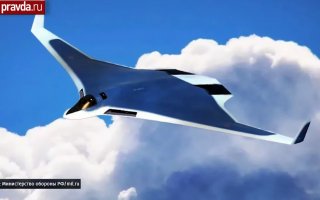PAK DA: Russia's Mysterious Stealth Bomber Is Coming
While little or nothing is known about the B-21 or the PAK DA in some respects, both appear slated to fire air-launched cruise missiles, weapons that clearly enable a wider range of attack options.
The first model of Russia’s new PAK DA stealth bomber is expected to be completed at some point this year, a development expected to lead toward additional prototypes and testing over the next several years.
This timeframe, should it come to fruition, aligns the emergence of the PAK DA with the U.S. B-21 which is also being completed and prepared for its first test flights and early operational assessments. Can it rival the U.S. B-21? Or the Chinese H-20? Those may not be answerable questions at the moment, but there do appear to be some similarities between the PAK DA and the U.S. B-2 or even B-21. Of course, the PAK DA’s horizontal blended wing-body shape is to be expected for these kinds of stealthy platforms. Yet available renderings of the PAK DA show rectangular-shaped inlets aligned with or somewhat parallel to the top of the fuselage.
Looking at the back of the B-21 and the PAK DA on available images show some potential design similarities as neither model has anything that looks like a protruding external exhaust or visible area from which heat can dissipate. Have one or both of these stealth bombers been engineered with any kind of cooling technology or exhaust management system to manage thermal signature?
While little or nothing is known about the B-21 or the PAK DA in some respects, both appear slated to fire air-launched cruise missiles, weapons that clearly enable a wider range of attack options. According to a TASS report from last year. “The PAK DA is expected to deploy Kh-102 nuclear-tipped stealthy cruise missiles, and a number of newer hypersonic designs including derivatives of the Kh-47M2,” the TASS story writes. This brings up yet another parallel. The U.S. B-21 is slated to fly armed with the new Long-Range Stand-off weapon, a nuclear-capable, air-launched cruise missile intended to hold targets at risk at greater standoff ranges to reduce the risk of destruction by enemy air defenses.
As for fuselage shape, the U.S. B-21 does appear to have more rounded and indented inlets when compared with the B-2 or the Russian PAK DA. The B-2 has small, protruding rectangular structures on top of the fuselage for inlets, and the PAK DA looks like it has a rectangular inlet built directly into the front end of the wing. The new B-21 bomber does appear to have a smaller or more blended incline between the fuselage and wings. Granted, protruding configurations of any kind, if even rounded or covered in a radar-absorbing exterior, are more likely to generate some kind of radar “ping” return from ground-based air defense systems. Vertical structures and uneven contours are therefore more likely to generate radar returns, as electromagnetic “pings” will discern the differences in shape.
The concept with these kinds of stealth bombers is to not only elude surveillance radar systems but also evade higher-frequency, more precise engagement radar, ensuring that the platform will not only be difficult or impossible to hit but also remain completely undetected. The idea is for adversaries to “not even know something is there.” A stealthy platform can succeed by appearing as a “bird” or “insect” to enemy radar, yet the precise measure of performance or efficacy against advanced air defenses may not be well known.
Kris Osborn is the defense editor for the National Interest. Osborn previously served at the Pentagon as a Highly Qualified Expert with the Office of the Assistant Secretary of the Army—Acquisition, Logistics & Technology. Osborn has also worked as an anchor and on-air military specialist at national TV networks. He has appeared as a guest military expert on Fox News, MSNBC, The Military Channel, and The History Channel. He also has a Master’s Degree in Comparative Literature from Columbia University.
Image: Reuters

